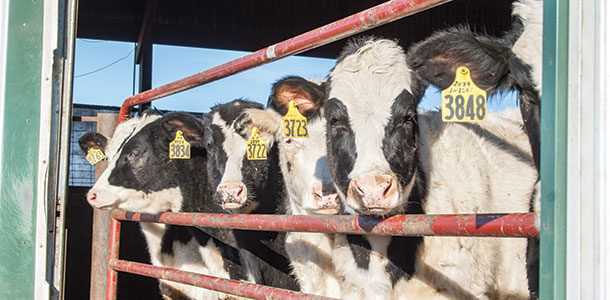The ties between dairy calf growth and adult performance are strong and circular. The first 45 to 50 days of a heifer calf’s life are critical for success, setting the stage for future health status, milk production, reproduction, and ultimately, longevity in the herd.
It’s been well documented that the nutrition program of calves and heifers is directly related to growth, disease resistance, timing of breeding and potential milk production performance.
Together, all of these factors also influence how well a heifer navigates her first transition period, which is of utmost concern to ensure herd longevity and productivity.
Production potentialbegins at birth
It may seem a little intense to focus on a replacement’s transition as soon as she’s born, but a heifer calf’s future success depends on a great start beginning on day one. Early nutrition is the foundation of performance later in life.
Results from a number of studies directly and indirectly show that calves fed more nutrients up to 8 weeks old produced more milk during their first lactation – as much as 3,000 additional pounds compared to calves fed a more restricted diet during the same period.
Researchers at Cornell University have confirmed the effects of this higher plane of nutrition. According to their data, the relationship between two factors, growth rate prior to weaning and intake over maintenance, and first-lactation milk yield are key. In addition, these are factors easily impacted by management decisions and actions.
“We discovered that for every 1 pound of average daily gain prior to weaning (or at least 42 to 56 days old), the heifers produced between 800 and 1,500 pounds more milk,” says Dr. Mike Van Amburgh, Cornell University professor of animal science.
They also learned that producers must account for energy needs beyond maintenance requirements during cold weather so calves receive the nutrients needed for growth, not just the energy needed for body heat generation.
He emphasizes that, “Anything that detracts from feed intake and subsequent pre-weaning growth rate reduces the opportunity for enhanced milk yield as an adult.”
Research data also suggest that the long-term milk response is related to protein synthesis. That means energy intake above maintenance, coupled with adequate metabolizable protein levels in the ration, are essential to “switch on” an animal’s signaling mechanism associated with long-term changes in productivity, Van Amburgh says.
The athlete heifer
When pre-weaning heifers get off to an optimal start, it makes it easier for producers to keep them on the right path toward a successful transition into the milking herd.
Proper nutrition at this next stage of development also is based on a sound nutrition foundation. Rations should include optimal levels of metabolizable protein to increase volumetric growth so heifers reach breeding size sooner.
Remember that breeding timing should be based on size goals, not strict age requirements. That’s because undersized heifers are usually less productive than those of optimal size when they reach the milking herd. Properly developed heifers partition less energy to growth and more to milk production in the first 150 days of lactation. They start their productive life sooner and peak higher with fewer transition problems.
Depending on breed and individual herd dynamics, Holstein heifers should be about 51 inches at the hip, about 55 percent of their dam’s mature bodyweight at breeding and about 82 to 85 percent of their dam’s mature bodyweight at calving.
Accuracy is important when it comes to determining whether a heifer is big enough to breed. If you don’t have a weight tape or hipometer on hand, use a tape measure and mark where 51 inches is in relation to the height of your headlocks or feed lane. That way, you can tell at a glance whether heifers have reached an acceptable size to enter the breeding pen.
On the other hand, overfeeding energy in relation to metabolizable protein can result in overconditioned heifers that lack the appropriate stature and capacity. These heifers, too, often have difficulties in the transition period that result in lowered production or health challenges that result in early departure from the herd.
From weaning through calving, you’re looking for heifers that look and perform like athletes, with strong muscle and bones and little fat.
Improvement needed
Once heifers are confirmed pregnant, they begin the journey toward lactation. Helping heifers prepare for their first lactation through proper nutrition and management is critical to successfully navigate their first transition and ensure heifers begin to generate income in a timely fashion.
While dairies have made strides in heifer nutrition, evidence suggests there is room to do an even better job in getting these animals through their first transition period and beyond.
According to data from the Council on Dairy Cattle Breeding, less than three-quarters of heifers make it through their first lactation. Twenty-five percent of first-calf Holsteins that do not complete their first lactation are removed from the herd due to poor milk production. And nearly 19 percent are removed for poor reproduction reasons. These removals are at a higher percentage than for any other parity.
Keep in mind the nutritional and management steps you took (or didn’t take) nearly two years ago are having an impact at this stage of the animal’s life.
“As an industry, people need to talk about metabolizable energy and protein intake and status relative to maintenance and stop talking about bottles, buckets, pounds and grams of dry matter, milk, milk replacer, etc.,” Van Amburgh says.
Instead, focus on managing calves and heifers so they get off to the best start possible, and then keep them on that path. PD
PHOTO
It’s been well documented that the nutrition program of calves and heifers is directly related to growth, disease resistance, timing of breeding and potential milk production performance. Photo byPDstaff.

Gene Boomer
Field Technical Services Manager
Arm & HammerAnimal Nutrition












